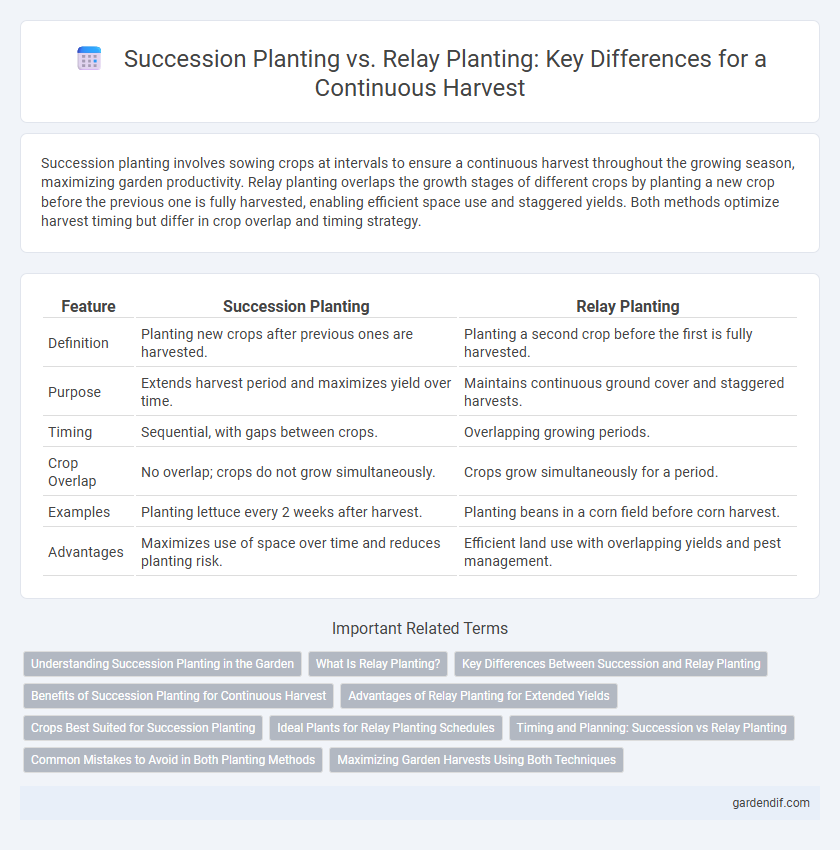
Succession Planting vs Relay Planting Illustration
Succession planting involves sowing crops at intervals to ensure a continuous harvest throughout the growing season, maximizing garden productivity. Relay planting overlaps the growth stages of different crops by planting a new crop before the previous one is fully harvested, enabling efficient space use and staggered yields. Both methods optimize harvest timing but differ in crop overlap and timing strategy.
Table of Comparison
| Feature | Succession Planting | Relay Planting |
|---|---|---|
| Definition | Planting new crops after previous ones are harvested. | Planting a second crop before the first is fully harvested. |
| Purpose | Extends harvest period and maximizes yield over time. | Maintains continuous ground cover and staggered harvests. |
| Timing | Sequential, with gaps between crops. | Overlapping growing periods. |
| Crop Overlap | No overlap; crops do not grow simultaneously. | Crops grow simultaneously for a period. |
| Examples | Planting lettuce every 2 weeks after harvest. | Planting beans in a corn field before corn harvest. |
| Advantages | Maximizes use of space over time and reduces planting risk. | Efficient land use with overlapping yields and pest management. |
Understanding Succession Planting in the Garden
Succession planting is a strategic gardening technique where crops are sown in intervals to ensure a continuous harvest throughout the growing season, optimizing garden space and productivity. This method involves planting a new crop as soon as the previous one is harvested, maintaining soil health and maximizing yield efficiency. Understanding succession planting allows gardeners to plan crop cycles effectively, reducing downtime in the garden and promoting sustainable growth patterns.
What Is Relay Planting?
Relay planting is a gardening technique where a second crop is sown or transplanted into a bed before the first crop is completely harvested, allowing continuous harvest and efficient use of space. This method differs from succession planting, which involves planting crops in intervals, as relay planting overlaps the growing periods of different crops. Relay planting maximizes yield by reducing gaps in production and maintaining soil productivity throughout the growing season.
Key Differences Between Succession and Relay Planting
Succession planting involves sowing the same crop at regular intervals to ensure continuous harvest over an extended period, whereas relay planting overlaps two or more crops in the same space to maximize land use but staggers their growth cycles. Key differences include timing and spacing: succession planting requires precise scheduling for repeated sowing, while relay planting integrates new crops before the current ones are fully mature, promoting efficient resource utilization. Both methods aim to increase yield, but succession planting emphasizes continuous production of one crop, and relay planting focuses on simultaneous cultivation to optimize garden productivity.
Benefits of Succession Planting for Continuous Harvest
Succession planting enables continuous harvest by staggering planting times of the same crop, ensuring fresh produce is available over an extended period rather than all at once. This method maximizes garden space efficiency by reducing downtime between crops, allowing for multiple harvests within a growing season. By maintaining a steady supply of mature vegetables, succession planting supports consistent yield and better resource management compared to relay planting.
Advantages of Relay Planting for Extended Yields
Relay planting maximizes garden productivity by overlapping crop growth stages, allowing continuous harvest without large gaps between crops. This method reduces soil disturbance and maintains nutrient levels, enhancing plant health and yield quality. By optimizing space and time, relay planting ensures extended harvest periods and consistent fresh produce supply.
Crops Best Suited for Succession Planting
Crops best suited for succession planting include leafy greens like lettuce, spinach, and kale, which thrive in continuous harvest cycles due to their fast growth and short maturity periods. Root vegetables such as radishes and carrots respond well to staggered sowing, allowing for a steady yield throughout the growing season. Herbs like basil and cilantro also perform well in succession planting, ensuring a fresh supply by planting at regular intervals.
Ideal Plants for Relay Planting Schedules
Ideal plants for relay planting schedules include fast-growing, hardy vegetables such as lettuce, radishes, and spinach, which allow continuous harvest by staggering planting times. Root crops like carrots and beets also perform well with relay planting due to their tolerance for varying soil conditions and flexible maturity periods. Incorporating herbs like basil and cilantro ensures frequent harvests while maximizing garden space efficiency.
Timing and Planning: Succession vs Relay Planting
Succession planting involves sowing crops at intervals to maintain a continuous harvest, maximizing yield over an extended period by carefully timing each planting after the previous crop's harvest. Relay planting overlaps growing cycles, planting a new crop before the previous one is fully harvested, optimizing space and time by ensuring field productivity without gaps. Both methods demand strategic planning of crop maturity rates and seasonal timing to enhance harvest efficiency and crop turnover.
Common Mistakes to Avoid in Both Planting Methods
Succession planting often suffers from overlapping crop maturity times, causing harvest congestion and reduced yield quality, while relay planting mistakes include improper spacing that hinders growth and limits sunlight exposure. Avoid planting crops with conflicting nutrient needs in succession, as this depletes soil fertility quickly and increases pest susceptibility. Ensuring accurate timing and compatible crop choices in both methods maximizes harvest efficiency and minimizes plant stress.
Maximizing Garden Harvests Using Both Techniques
Succession planting involves planting new crops immediately after harvesting the previous ones to maintain continuous harvests and optimize garden space year-round. Relay planting overlaps different crops in the same bed by staggering their planting times, allowing one crop to mature as another is just beginning, which minimizes downtime and maximizes yield. Combining succession and relay planting techniques effectively increases garden productivity by extending harvest periods and enhancing resource utilization.
Succession Planting vs Relay Planting Infographic

 gardendif.com
gardendif.com